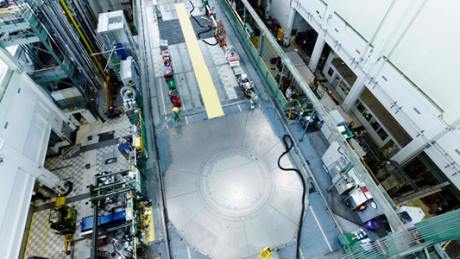Separate incidents at research reactors supplying molybdenum-99 (Mo-99) have once again illustrated the fragile nature of the medical isotope's supply chain. Meanwhile a unique new facility has started production of lead-212.
 |
| Canada's NRU (Image: AECL Chalk River Laboratories) |
Production was suspended at South Africa's Safari 1 after a release of iodine and noble gas during cleaning processes on 2 November. The release, caused in a "very rare combination of circumstances" by a chemical reaction between cleaning materials used in preparation for a new production run was "momentary and minimal," according to an update issued on 11 November by South African Nuclear Energy Corporation (Necsa) subsidiary NTP Radioisotopes. The release was well within regulatory limits and, apart from the "minimal" atmospheric releases, was contained within the Pelindaba facility with no impact on facility operators or the public, NTP said. However, production at the site was halted pending the completion of investigations, although NTP promised a return to production "as soon as possible" in its 11 November statement.
Supplies of the isotope were further compromised by the temporary closure of molybdenum production lines at NRG's Dutch facility because of concerns over levels of uranium in a liquid waste tank on 8 November. NRG's High Flux Reactor (HFR) is currently out of service while investigations are ongoing into control rod issues identified in early October. The company subsequently announced that it has launched a "return to service" program that it says will help it to avoid unplanned outages in the future. As part of that process, it is bringing all nuclear facilities and connected processes at its Petten site into a safe shutdown mode which could last up to three months.
New lead-212 facility
A new facility for the production and purification of lead-212 (Pb-212) has been inaugurated by Areva Med. The Maurice Tubiana Facility at Bessines-sur-Gartempe in Fance will provide sufficient amounts of the high-purity isotope for clinical development. Pb-212 is a promising agent for use in the field of Targeted Alpha Therapy (TAT) or alpha radioimmunotherapy, and is currently undergoing clinical trials at the University of Alabama at Birmingham in the USA.
The Maurice Tubiana facility recovers the isotope from recycled uranium fuel and also from thorium from the Areva's past industrial activities.
Another major supplier of the Mo-99, Canada's Chalk River Laboratory, was forced out of action on 19 November for repairs to the flask used to transport fuel rods and other components including Mo-99 rods in and out of the NRU reactor. Operator AECL announced that it would be unable to meet its planned isotope deliveries for the week ending 23 November, although repair activities were started immediately and the company anticipated a return to service within the week.
After the suspension of the South African and Dutch operations, European industrial group the Association of Imaging Producers and Equipment Suppliers (AIPES) said the companies involved had initiated "all possible necessary coordinated actions in order to mitigate the risks for the security of supply" with reserve capacity being activated wherever possible.
Mo-99 is used in hospitals to generate short-lived technetium-99m for medical imaging procedures. Its short half-life of only 66 hours means that Mo-99 cannot be stockpiled, so the world relies on regular and reliable supplies of the isotope. However, recent years have seen global shortages when several of the handful of ageing research reactors used to produce the vital isotope have been out of action. This has prompted efforts to investigate production of Mo-99 via other routes, such as in cyclotrons, as well as efforts to increase capacity at existing suppliers. Australia's OPAL reactor, which started up in 2007, could potentially supply half of the world's demand. Work is currently under way on an expanded molybdenum production facility, with the new capacity due to come online in 2016.
Researched and written
by World Nuclear News




_69218.jpg)

_50545.jpg)
_28367.jpg)
_76087_55556.jpg)




